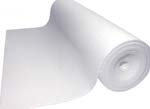If you’re decorating a room but don’t just want plain walls, wallpaper is the choice for you. With hundreds of colour, pattern and texture options though, taking your pick can be a confusing process. We’ve detailed the different types of wallpaper below to get you started.
Lining Paper
Lining paper pretty much does what it says on the tin. It’s a plain paper which is used to cover imperfections or dark colours on a wall prior to wallpapering or painting.
Lining paper is available in various grades, or thicknesses, with the thicker types being much better at covering imperfections, and also easier to hang, being less likely to tear.
When using lining paper prior to wallpapering, it should be hung horizontally on the wall, so that the joins will never match up with the wallpaper on top.
If you are planning to paint the lining paper, you can hang it vertically as per normal wallpaper.

Veneer Wallpaper Lining
Polystyrene Sheeting
Rolls of thin polystyrene veneer can be used as a wallpaper lining. This makes the walls feel much warmer and reduces condensation in rooms, so it can be useful in bathrooms and kitchens, or bedrooms that have a condensation problem.
The only problem with polystyrene is that it can easily be dented and marked, so it should be avoided in busy, high-traffic areas.

Polystyrene Veneer Lining Paper
Wood Chip Wallpaper
A leftover from the 1970’s, when it was very popular, woodchip paper is a cheap way of covering imperfect walls, but is best avoided if possible.
Also known as ingrain wallpaper, woodchip is made by trapping small chips of wood in the paper when it is manufactured.
It is available in a variety of grades, and as always the higher grade, or thicker papers, provide the best coverage and are easier to hang. Woodchip comes in plain white and is designed to be painted over with emulsion.

Woodchip Wallpaper
Anaglypta Wallpaper
Anaglypta wallpapers are thick, durable papers that are embossed with a pattern. There are a huge number of patterns available.
Sometimes anaglyptas are available in colour, but usually they are designed to be painted with emulsion paint.
The typically high grade of these papers make them easy to hang, and the embossing means they are suitable for covering slight imperfections in the wall. However, they are prone to stretching, so be careful when hanging.

Anaglypta Wallpaper
Supaglypta Wallpaper
Supaglypta is, as the name suggests, a super version of anaglypta wallpaper.
Cotton fibres are used in the manufacturing process to produce the embossed effect, making supaglypta particularly tough and durable.
The pattern on supaglyptas is often more complex and raised slightly higher than on an anaglypta.
Their durability means that supaglyptas are suitable for high-traffic areas such as hallways and stairways.

Supaglypta Wallpaper
Flock Wallpaper
Flock wallpaper is one of the more expensive options. A velvet-like fibre pattern gives a very luxurious, old-fashioned feel.
It is hard to resist stroking a flock wallpaper, so they can easily become marked.
Flock is also a tricky wallpaper to hang, as it takes skill to avoid getting any paste on the flock, which will mark and ruin the texture.

Flock Wallpaper
Foil Wallpaper
Metalized papers can be very attractive. These reflective patterns can help to lighten up a dark corner, but be careful in your choice as they tend to use a lot of dark colours.
Because of the reflective nature of these papers, foil wallpaper shows any lumps and bumps on the wall so make sure your wall is as smooth as possible before you start, or use a lining paper.
Be careful not to get any wallpaper paste on the foil as it will ruin the reflective coating. Foil papers are often ‘paste the wall’ type papers as this makes them easier to hang.

Foil Wallpaper
Printed Wallpaper
Printed papers come in a huge range of colours, designs and qualities, from mass-produced, machine-printed designs to high quality hand-printed patterns.
The hand-printed versions are of course more expensive than their machine-printed counterparts.
Do not use printed wallpapers in areas where there is a lot of steam or condensation, as the inks used are often water-based.
Be careful when hanging printed wallpapers, as the delicate paper can tear easily and the complex patterns can be hard to match up.

Printed Wallpaper
Vinyl Wallpaper
Vinyl wallpapers consist of a printed skin of vinyl stuck onto a base layer of paper.
Vinyl papers are tough, hardwearing and washable, although some have a thicker layer of vinyl than others so will be more durable.
Vinyl papers are suitable for kitchens and bathrooms as they are resistant to condensation and steam.

Vinyl Wallpaper
Blown Vinyl Wallpaper
Blown or expanded vinyl looks similar to an embossed or anaglypta paper, with a raised pattern, but the pattern is coloured. Vinyl paper cannot be painted over.

Blown Vinyl Wallpaper
Washable Wallpaper
Although vinyl wallpapers are washable, there are also wallpapers available which are specifically marketed as washable.
These papers are printed with water-resistant ink and coated with a layer transparent plastic.
Washable papers are particularly suited to kitchens, where steam and grease gather, meaning the walls require regular washing.

Washable Wallpaper

